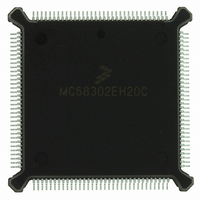MC68302EH20C Freescale Semiconductor, MC68302EH20C Datasheet - Page 207

MC68302EH20C
Manufacturer Part Number
MC68302EH20C
Description
IC MPU MULTI-PROTOCOL 132-PQFP
Manufacturer
Freescale Semiconductor
Datasheets
1.MC68302AG20C.pdf
(4 pages)
2.MC68302AG20C.pdf
(2 pages)
3.MC68302AG20C.pdf
(13 pages)
4.MC68302EH20C.pdf
(481 pages)
Specifications of MC68302EH20C
Processor Type
M683xx 32-Bit
Speed
20MHz
Voltage
5V
Mounting Type
Surface Mount
Package / Case
132-MQFP, 132-PQFP
Family Name
M68000
Device Core
ColdFire
Device Core Size
32b
Frequency (max)
20MHz
Instruction Set Architecture
RISC
Supply Voltage 1 (typ)
5V
Operating Temp Range
0C to 70C
Operating Temperature Classification
Commercial
Mounting
Surface Mount
Pin Count
132
Package Type
PQFP
Lead Free Status / RoHS Status
Lead free / RoHS Compliant
Features
-
Lead Free Status / Rohs Status
Compliant
Available stocks
Company
Part Number
Manufacturer
Quantity
Price
Company:
Part Number:
MC68302EH20C
Manufacturer:
Freescale Semiconductor
Quantity:
10 000
Part Number:
MC68302EH20C
Manufacturer:
FREESCALE
Quantity:
20 000
Company:
Part Number:
MC68302EH20CB1
Manufacturer:
Freescale Semiconductor
Quantity:
10 000
Company:
Part Number:
MC68302EH20CR2
Manufacturer:
Freescale Semiconductor
Quantity:
10 000
- MC68302AG20C PDF datasheet
- MC68302AG20C PDF datasheet #2
- MC68302AG20C PDF datasheet #3
- MC68302EH20C PDF datasheet #4
- Current page: 207 of 481
- Download datasheet (2Mb)
RESTART TRANSMIT Command
RESET BCS CALCULATION Command
ENTER HUNT MODE Command
4.5.13.5 BISYNC Control Character Recognition
The BISYNC controller can recognize special control characters. These characters are used
to “customize” the BISYNC protocol implemented by the BISYNC controller and may be
used to aid its operation in a DMA-oriented environment. Their main use is for receive buff-
ers longer than one byte. In single-byte buffers, each byte can easily be inspected, and con-
trol character recognition should be disabled.
MOTOROLA
mand may be used when it is necessary to abort transmission and transmit an EOT con-
trol sequence. The EOT sequence should be the first buffer presented to the BISYNC
controller for transmission after re-enabling transmission.
The STOP TRANSMIT command must be issued before the SCC mode register is used
to disable the transmitter if the transmitter is to be re-enabled at a later time.
The RESTART TRANSMIT command is used to begin or resume transmission from the
current Tx BD number (TBD#) in the channel's Tx BD table. When this command is re-
ceived by the channel, it will start polling the ready bit in this BD. This command is expect-
ed by the BISYNC controller after a STOP TRANSMIT command, after the STOP
TRANSMIT command and the disabling of the channel in its mode register, or after a
transmitter error (underrun or CTS lost) occurs.
If the transmitter is being re-enabled, the RESTART TRANSMIT command must be used
and should be followed by the enabling of the transmitter in the SCC mode register.
The RESET BCS CALCULATION command resets the receive BCS accumulator imme-
diately. For example, it may be used to reset the BCS after recognizing a control charac-
ter, signifying that a new block is commencing (such as SOH).
After a hardware or software reset and the enabling of the channel in the SCC mode reg-
ister, the channel is in the receive enable mode and will use the first BD in the table.
The ENTER HUNT MODE command is used to force the BISYNC controller to abort re-
ception of the current block, generate an RX interrupt (if enabled) as the buffer is closed,
and enter the hunt mode. In hunt mode, the BISYNC controller continually scans the input
data stream for the SYN1–SYN2 sequence as programmed in the data synchronization
register. After receiving the command, the current receive buffer is closed, and the BCS
is reset. Message reception continues using the next BD.
If an enabled receiver has been disabled (by clearing ENR in the SCC mode register), the
ENTER HUNT MODE command must be given to the channel before setting ENR again.
The BISYNC controller will remain in the transparent or normal
mode after receiving the STOP TRANSMIT or RESTART
TRANSMIT commands.
MC68302 USER’S MANUAL
NOTE
Communications Processor (CP)
4-87
Related parts for MC68302EH20C
Image
Part Number
Description
Manufacturer
Datasheet
Request
R
Part Number:
Description:
Manufacturer:
Freescale Semiconductor, Inc
Datasheet:

Part Number:
Description:
MC68302 Configuring the Chip Selects on the MC68302
Manufacturer:
Motorola / Freescale Semiconductor

Part Number:
Description:
MC68302 Design Concept - Expanding Interrupts on the MC68302
Manufacturer:
Motorola / Freescale Semiconductor

Part Number:
Description:
MC68302 MC68302 Adapting a WAN Controller to a LAN Environment
Manufacturer:
Motorola / Freescale Semiconductor

Part Number:
Description:
MC68302 EKB Applications - Power Measurements on the MC68302
Manufacturer:
Motorola / Freescale Semiconductor

Part Number:
Description:
MC68302 Interfacing the MC68020 to a Slave MC68302
Manufacturer:
Motorola / Freescale Semiconductor

Part Number:
Description:
MC68302 MC68302 Software Performance
Manufacturer:
Motorola / Freescale Semiconductor

Part Number:
Description:
MC68302 Evaluating EDX on the ADS302
Manufacturer:
Motorola / Freescale Semiconductor

Part Number:
Description:
MC68302 Design Advisory #1 - MC68SC302 Passive ISDN Protocol Engine
Manufacturer:
Motorola / Freescale Semiconductor

Part Number:
Description:
MC68302, MC68360, and MPC860 Characteristics and Design Notes for Crystal Feedback Oscillators
Manufacturer:
Motorola / Freescale Semiconductor
Part Number:
Description:
Mc68302 Integrated Multi-protocol Processor
Manufacturer:
Freescale Semiconductor, Inc
Datasheet:
Part Number:
Description:
Manufacturer:
Freescale Semiconductor, Inc
Datasheet:
Part Number:
Description:
Manufacturer:
Freescale Semiconductor, Inc
Datasheet:
Part Number:
Description:
Manufacturer:
Freescale Semiconductor, Inc
Datasheet:
Part Number:
Description:
Manufacturer:
Freescale Semiconductor, Inc
Datasheet:











